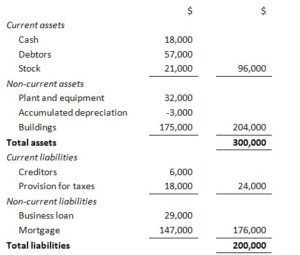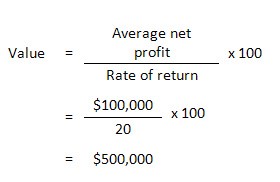Valuing your business

Although there are several formulas you can use, there are no black-and-white answers on valuation techniques.
It’s important to conduct your own research, then get independent advice from a business valuer or broker.
Here are four of the most commonly used valuation methods:
1. Asset valuation
2. Capitalised future earnings
3. Earnings multiple
4. Comparable sales
- Asset valuation method
• Adds the value of the assets of the business and subtracts its liabilities
• Determines what the business would be worth if it were closed down today and sold
• Doesn’t take into account the ability of those assets to generate wealth in the future
• Doesn’t take into account goodwill
• For these reasons, asset valuation may understate the true value of the business
- How it works
Add up the value of all the assets such as cash, stock, plant and equipment and receivables
• Add up liabilities, such as any bank debts and payments due
• Subtract the liabilities from the assets to get the net asset value
- Example
• Richard wants to buy a manufacturing business. Here’s an extract from the balance sheet:

• The business has $300,000 of assets and $200,000 of liabilities
• The net asset value is $100,000
- What about goodwill?
• Goodwill is the difference between the true value of a business and the value of its net assets
• It can be crucial to the value of retail and service-based businesses
• Asset valuation doesn’t include a value for goodwill, so may understate the true value of a business
• For example, if you value a hair salon, where service, location and reputation are important, the value of any goodwill would have to be added to net assets to get a valuation
• Goodwill may or may not be transferred if you buy a business, since it can come from physical features like location, or from personal factors, like the owner’s reputation or relationships with customers or suppliers
• If a business is underperforming and has no goodwill, then using net asset valuation could be an accurate way to value it
- Capitalised future earnings
• When you buy a business, you’re buying its assets and the right to all profits the business might generate
• Capitalising future earnings is the most common method used to value small businesses
• It considers the rate of return on investment (ROI) that you can expect to get from the business
- How it works
• Work out the average net profit of the business over the last three years using its profit-and-loss statements, adjusting profit for one-off expenses or other irregular items each year
• Decide on the annual rate of return you’re looking for (e.g. 20 per cent)
• There are no rules about the number you choose, except higher risk should give higher returns
• Compare the business with other investment opportunities
• You can also look at the rate of return that similar businesses in your industry achieve
• Divide net profits by the rate of return to determine the value of the business, then multiply by 100
- Example
David is looking at buying a bakery business with average net profits of $100,000 per annum after adjustments. David wants an annual rate of return of 20 per cent. The capitalised earnings valuation is:

• David will pay $500,000 now for a business he believes will earn $100,000 a year plus 20 per cent more profit each year into the future
Earnings multiples’ earnings before interest and tax (EBIT) by your selected multiple
• For example, you might value the business at twice its annual earnings – so a business with an EBIT of $200,000 might be valued at $400,000
• The multiple you choose will depend on the industry and the growth potential of the business
• A service-based business might be valued at as little as one year’s earnings, while an established business with sustainable profits might sell for as much as six times earnings
- Comparable sales
• Whatever other valuation method you use, you should also look at prices for recent sales of similar businesses
• Research what’s happening in the market you’re interested in
• Speak to business brokers and gauge their feelings about the business’ value
• A broker may know what similar operations are selling for and how the market is placed
• Check business-for-sale listings in industry magazines, newspapers or websites





